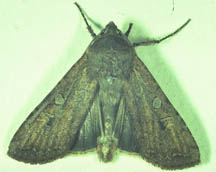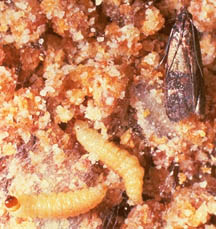by W.S. Cranshaw 1
Quick Facts…
- Moths found in the home do not necessarily indicate insect infestations inside. Many household moths appear when the insects inadvertently move indoors.
- In eastern Colorado, flights of the army cutworm (“miller” moths) typically cause nuisance problems in late spring.
- Indian meal moths can infest dried food products within a home and are a common problem in stored foods.
- Clothes moth infestations are rare in Colorado.
Several kinds of moths can be found in and around homes in Colorado. Few of these moths indicate insect infestations within a home. Instead, most indoor moths occur when common species found outdoors inadvertently move indoors when seeking shelter. The most familiar of these is the army cutworm, the Colorado “miller” that annually flies across eastern Colorado in mid- to late spring.
A few moths do indicate possible infestations of food or woolen clothing. Indian meal moths frequently infest coarse grain, dried fruit and similar items. Clothes moths also occur, although they are rare in Colorado.
 |
Figure 1: The most common
|
Army Cutworms (Colorado’s “Miller” Moths)
The most common nuisance moth in Colorado is the army cutworm. (See Colorado State University Extension fact sheet 5.597, Miller Moths for more information.)These moths can be extremely annoying when they get into homes and cars, but they do not breed indoors and die within a few days. Army cutworm moths are about 1 inch long and variable in color. Usually they are gray or brown with two characteristic light spots on each wing.
Life Cycle
Army cutworms have an unusual life cycle. The caterpillar stage (larvae) overwinter in the soil, primarily in the alfalfa and wheat fields of eastern Colorado. In the spring, they feed and complete their development, causing some economic damage to Crops. Moths usually emerge in May or June, with the majority emerging during a short period.
Shortly after emergence, the moths migrate to higher elevations in the mountains to feed on flowering plants, crossing the heavily populated areas of the state. During this migration, some of the moths move into buildings, causing nuisance problems. They stay in the high elevations until late summer to early fall, when they return to the plains. Fall migrations are smaller and less frequently observed. Upon returning to the high plains, the moths lay eggs in the soil. Larvae begin to feed before overwintering.
Control
For nuisance moths such as the army cutworm, home insecticides work poorly. During periods of heavy moth flights, seal any openings, reduce evening lighting (which attracts them), and watch the door as you enter the house at night to prevent moth entrance. The few that enter can be controlled with fly swatters or vacuum cleaners, or you can wait for the insects to die on their own in a few days.
The problem will decline as the continued migration moves the moths through the area to the mountains. Moths can be trapped by keeping a light suspended over a bucket of water during the night.
 |
Figure 2: Indian meal moths
|
Indian Meal Moths
Continued occurrence of small moths in the home for periods longer than three weeks typically indicates infestations of Indian meal moth (see fact sheet 5.598, Indian Meal Moth). Adult Indian meal moths are small (wing spread of about 5/8 inch) and have a broad, grayish band on their bronze-colored wings. Adult moths do not feed, but immature meal moths are capable of developing on almost any dried food product in the home. This general feeder has been found on grain, grain products, dried fruits, dried vegetables, seeds, nuts, graham crackers, powdered milk and dog food. There usually is some webbing on the infested product. Most household infestations originate from purchase of infested foods, but some movement of the moths from outdoors is possible in warm weather.
Control
Control of Indian meal moths requires a thorough search of all dried food, including things like dog food and bird seed that often are overlooked. The problem will more likely have developed in foods that have not been used for some time. Small, white worms and webbing indicate sources of the problem. Discard infested foods if possible and examine the remaining food to kill any insects that are left. The easiest way to kill Indian meal moths is to place the food package in the freezer for several days. Warming the infested food in an oven or microwave also can kill insect eggs and larvae. Temperatures of 125 to 130 degrees F maintained for three hours should be adequate.
Because of the potential hazard of food contamination, insecticides are not recommended for control of Indian meal moths in houses. After treating or discarding all potential food for the moth, keep everything stored in tight containers, outdoors, or in the refrigerator for a couple of weeks. After adult moths are no longer observed, food can be returned to storage areas because the source of the infestation should be eliminated.
 |
Figure 3: Webbing clothes
|
Clothes Moths
Clothes moths have been of great economic importance in the past but are rarely a problem today. Almost all insect-related clothing damage results from carpet beetles (see fact sheet 5.549, Carpet Beetles). Most clothes moth problems in Colorado probably originate on imported woolen goods that are infested. The webbing clothes moth generally is light in color and small (about 1/2 inch from wing tip to wing tip). There are reddish, fluffy hairs at the top of its head and its antennae are slightly darker than the rest of the body. Less common is the casemaking clothes moth, which is slightly smaller and more of a brown color than the webbing clothes moth. Distinct spots often are found on the wings. Their name comes from the larvae’s habit of weaving a case of silk and fabric in which to live. Both species of clothes moths can develop only on woolen fabrics and furs. In heated buildings with plenty of food, they produce about four generations per year.
Control
Female moths rarely fly until they have laid most of their eggs, so simply killing flying moths will not control them. Although clothes moths are no longer abundant, do take preventive measures for more expensive woolen or fur articles. Dry cleaning kills all stages of the insect. Place the articles in airtight containers to prevent reinfestation. Cedar chests and moth balls do repel some moths, but will not consistently kill existing insects. However, paradichlorobenzene (PDB) moth crystals are lethal to all stages of clothes moths and carpet beetles. Hanging a DDVP (dichlorvos) pest strip with clothing should also reduce infestations in closets. When using these products, be careful to avoid excessive insecticide exposure.
1 Colorado State University Extension entomologist and professor, bioagricultural sciences and pest management. 10/97. Reviewed 3/08.
Colorado State University, U.S. Department of Agriculture, and Colorado counties cooperating. CSU Extension programs are available to all without discrimination. No endorsement of products mentioned is intended nor is criticism implied of products not mentioned.
Go to top of this page.





